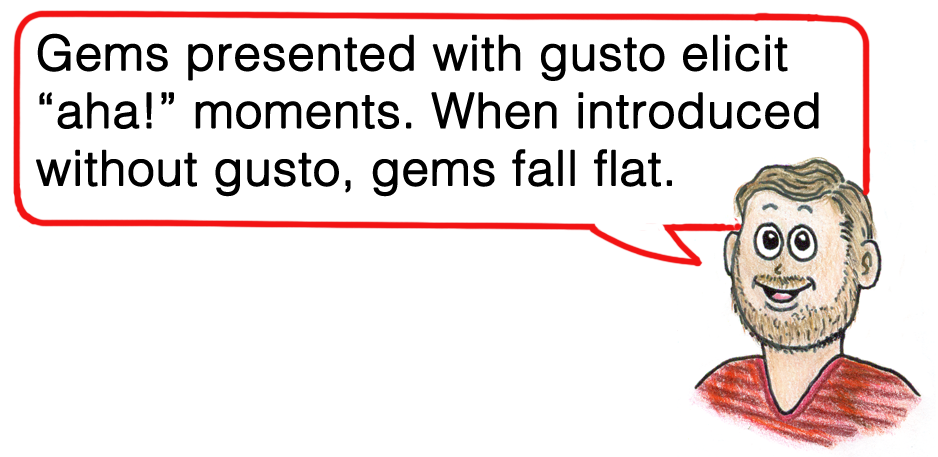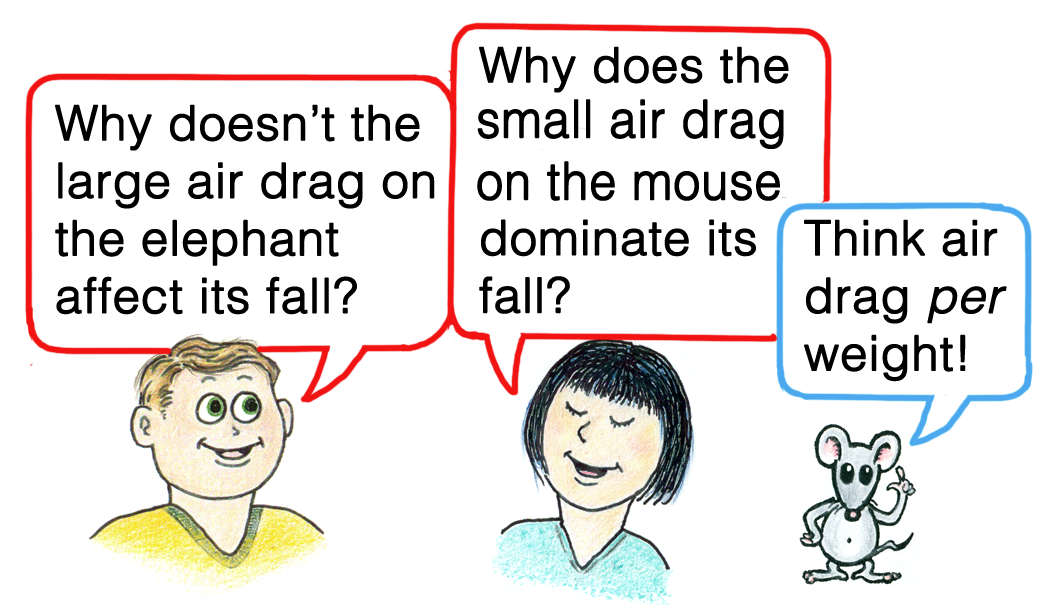focus on physics
Tips for Teaching the Physics of Falling
The Science Teacher—March/April 2023 (Volume 90, Issue 4)
By Paul G. Hewitt
A message from Paul G. Hewitt:
Now in my retirement years, I wish to share my 34 lessons of Conceptual Physics Alive! with all—especially teachers. This is a free gift, with no strings attached. Each of the 34 lessons can be streamed or downloaded at https://Conceptual.Academy.
There is no part of physics that is without interesting nuggets of information. As mentioned in recent Focus on Physics articles, we call these nuggets gems. Properly presented, gems can elicit “aha!” moments in our classes. We’ll cite some I’ve experienced when teaching the physics of falling, with special emphasis on classroom timing.
The importance of timing in teaching
Whether a gem is greeted with student enthusiasm in your class or not depends on timing. It’s important that the gem be clearly enunciated, and when appropriate, with gusto. And you often can enhance your gem by following it up with a punchline that wraps up its essence.

Demonstration fiasco
As an example of poor timing, I’m reminded of the time that Dave, a new teaching colleague, asked my advice for his second meeting with his class. He wanted an interest-builder to lead up to his lesson on acceleration and the effects of air resistance. I told him of a favorite classroom activity that would guarantee student attention—the “book and paper drop.” It’s simple enough. Drop side by side a book from one hand and a sheet of paper from your other hand onto your table, but not from a height that would damage the book.
It’s no surprise that the book falls faster than the sheet of paper. It’s obvious to the class that air resistance, which we can call air drag, has a much greater effect on the falling sheet of paper than on the bulkier book. Tell the class you’ll repeat the drop, only this time you’ll place the sheet of paper beneath the book. Ask which will fall faster to the table? When you drop the combination, nobody is surprised to see that both reach the table together. No big deal. The book presses downward on the paper as it falls, so of course both fall at the same speed.
For a bit of humor, ask what would happen if the paper instead were inserted between pages within the book. Again, the book carries the sheet of paper with it as it falls. Now for the point of this activity: Tell them that this time you’re placing the sheet of paper on top of the book before you drop it (Figure 1). Aha! This merits more thinking. So, you again ask, “Which will fall faster?

Poor timing
Here’s where timing is crucial. I clearly advised David NOT to show the drop when the paper was atop the book. Instead, tease the class. Refuse to show it. Do NOT offer an explanation. Instead, perhaps say you’ll quiz them on this during the next class meeting. If they want an answer sooner, they can try it at home. In any event, you’ll not give an answer until the next class meeting. The point of this is to go further than arousing class interest—to have students perform the activity outside of class.
Advice not taken
How many of us take all the advice given by others? David didn’t. I eavesdropped on his class outside the classroom door. He got off to a good start. But I was aghast to hear him drop the book with paper atop it and then articulate a well-worded explanation! David blew it, instead succumbing to the satisfaction that comes with presenting a clear explanation while it was fresh on his mind. Aha! This is a prime example of the difference between a rookie and a seasoned teacher. David was clearly a rookie. A seasoned teacher has learned to be clever about timing in dispersing good information. Soon after, David left classroom teaching and became an administrator.

More on air drag
Not a lot of physics is learned in the simple book-paper drop demonstration. As said, its main purpose is to elicit student interest, and that’s enough if you’re pressed for time. With more time you can go further and ask two questions. First, which experienced greater air resistance in falling—the book or the sheet of paper? Second, upon which was air resistance most effective in altering the fall?
Let’s exaggerate and substitute an elephant for the book and a mouse for the sheet of paper (Figure 2). The questions are different, the first asking about the force and the second asking about the effect of that force. Different questions, different answers. The larger elephant clearly has more cross-sectional area and plows through more air when falling, and being so much heavier compared to air drag, it also falls at a greater speed. The effect of air drag is nil. Not so for the mouse, for which air drag plays a dominant role. In a short time it reaches a terminal speed, while the elephant continually accelerates.

In equation form
The equations of physics guide thinking. Let’s frame the above questions in terms of acceleration. Newton’s second law tells us

The net force on any falling object is its weight mg minus air resistance R. So we can say


We see that mg acts in the direction of fall, downward, and R acts against the direction of motion, upward. The net force is the difference between mg and R. For the elephant, mg is huge and R in comparison is tiny—tiny enough to be negligible. For the mouse, mg is tiny and R quickly builds up to equal mg. We see very quickly that mg – mg = zero. Acceleration of the falling mouse becomes zero. Here we distinguish between which encounters more air drag, and for which is it important. The cause and the effect have different answers. Shaping clear thinking is a big part of physics instruction.
Terminal speed
When the air resistance on a falling body builds up to equal the weight of the body, no further increase in speed occurs. Acceleration becomes zero. We can say acceleration terminates with no further increase in falling speed. We call the speed at which acceleration no longer occurs terminal speed. When direction is important, we speak of terminal velocity. Once terminal speed or velocity is reached, no further increase of speed or velocity occurs during fall. Parachuting provides good examples. Your class will find a more lively example with a falling cat (Figure 3).

Falling cat
To teach terminal speed, and at the risk of causing squeamishness, ask your students to consider a cat falling from a tall building into a safety net below. (If you don’t mention the safety net, be prepared for some classroom disruption!) Tell them that a cat falling from 20 stories will reach terminal velocity. What does this mean? It means that falling from more than 20 stories high will result in no greater speed. Ask your class to compare the speeds at which the cat will land from 21 stories, 25 stories, or 50 stories. The falling speeds at the safety net at the bottom of the fall will be the same, however high the fall above 20 stories! This gem of information elicits a nice “aha!”
First speed, then acceleration
Switch gears and then ask for the cat’s acceleration as it nears the net. The answer is zero (“Aha!”). That’s because the cat has already reached terminal velocity. One more: What’s the cat’s acceleration after bouncing from the net? This time, g, yet another “aha!”
Further study
Learning physics requires being able to distinguish between closely related concepts. In a study of motion, speed is a more familiar concept in our everyday world. Even a change in speed is intuitive. But the time rate of change of speed is not intuitive. It must be learned. Please remember that it took people nearly 2,000 years from the time of Aristotle to reach a clear understanding of motion. So be patient with your students when they find that some hours are required to achieve as much. Learning to distinguish between speed, velocity, and acceleration is a significant first step for the continued study of physics. After this distinction is clear, but not before, guide your class onward to Newton’s laws of motion and beyond. Learning these laws is learning the laws of nature.
On the web
For more on falling see Screencasts 12–18, and 20–23 on www.HewittDrewIt.com. There are two screencasts for teachers, 148 student-oriented tutorial lessons covering a broad swath of physics, and links to related materials. See also www.ConceptualAcademy.com.
Paul G. Hewitt (pghewitt@aol.com) is the author of the new 13th edition of Conceptual Physics; Conceptual Physical Science, 6th edition, coauthored with Leslie Hewitt and John Suchocki; and Conceptual Integrated Science, 3rd edition, with Suzanne Lyons, John Suchocki, and Jennifer Yeh.
Physical Science Physics Teacher Preparation Teaching Strategies High School


